
After Fukushima, fish tales
アフター福島~魚のお話
By ALEX ROSLIN, Special to The Gazette
January 13, 2012 9:06 PM
After the world’s worst nuclear accident in 25 years, authorities in Canada said people living here were safe and faced no health risks from the fallout from Fukushima.
ここ25年で世界最悪の放射能事故の後で、カナダ政府筋は、カナダの住民は安全で、福島からの降下物から健康に与えるリスクはない、と述べました。
They said most of the radiation from the crippled Japanese nuclear power plant would fall into the ocean, where it would be diluted and not pose any danger.
又、日本の機能を失った原子力発電所からの放射能のほとんどが海に降下し、薄められるので、危険を引き起こすことはない、と述べたのです。
Dr. Dale Dewar wasn’t convinced. Dewar, a family physician in Wynyard, Sask., doesn’t eat a lot of seafood herself, but when her grandchildren come to visit, she carefully checks seafood labels.
Dale Dewar医師は納得していませんでした。サスカチワン州、Wynyardの開業医、Dewar医師は、自分は海産物はあまり食べないけれど、孫たちが尋ねてきたときは、海産物のラベルを注意深く確認しています。
She wants to make sure she isn’t serving them anything that might come from the western Pacific Ocean.
孫たちに太平洋西部からのものを一切出さないように、念を入れたいと思っているのです。
Dewar, the executive director of Physicians for Global Survival, a Canadian anti-nuclear group, says the Canadian government has downplayed the radiation risks from Fukushima and is doing little to monitor them.
Dewar医師は、 (IPPNWのカナダ支部である)グローバルサバイバル医師団(PGS)の取締役であり、カナダ政府が福島からの放射能の危険性を小さく見せようとし、ほとんどモニタリングをしていないのだと言います。
“We suspect we’re going to see more cancers, decreased fetal viability, decreased fertility, increased metabolic defects – and we expect them to be generational,” she said.
「癌の増加、胎児の生育能力低下、不妊の増加、新陳代謝欠陥の増加を見ることになるでしょう。それは何世代にも引き継がれていくと思われるのです。」
And evidence has emerged that the impacts of the disaster on the Pacific Ocean are worse than expected.
この災害が太平洋に与えた影響は、予測していたより悪いという証拠が出てきています。
Since a tsunami and earthquake destroyed the Fukushima Daiichi Nuclear Power Plant last March, radioactive cesium has consistently been found in 60 to 80 per cent of Japanese fishing catches each month tested by Japan’s Fisheries Agency.
去年の3月に、津波と地震が福島第一原子力発電所を破壊して以来、日本水産庁による毎月の調査によると、放射性セシウムは、漁獲されたものの60-80%に、ずっと発見され続けているのです。
In November, 65 per cent of the catches tested positive for cesium (a radioactive material created by nuclear reactors), according to a Gazette analysis of data on the fisheries agency’s website. Cesium is a long-lived radionuclide that persists in the environment and increases the risk of cancer, according to the United States Environmental Protection Agency, which says the most common form of radioactive cesium has a half-life of 30 years.
水産庁のウェブサイトからのGazette紙のデータ分析によると、11月には、65%の漁獲物にセシウム(原子炉で造られた放射性物質)が検出されています。セシウムは環境に長く存在する放射性物質で、アメリカ合衆国環境保護庁によると、癌発症の危険を高めるものです。放射性セシウムは最もよく知られた放射性物質で、半減期が30年とのこと。
The Canadian Food Inspection Agency, which monitors food safety, says it is aware of the numbers but says the amounts of cesium detected are small.
食品安全のモニタリングを行うカナダ食品検査庁は、その数は認識しているけれど、検出されたセシウムの量は小さいのだ、と言います。
“Approximately 60 per cent of fish have shown to have detectable levels of radionuclides,” it said in an emailed statement.
「約60%の魚に検出可能なレベルの放射性物質が示されています。」とカナダ食品検査庁はEメールで述べました。
“The majority of exported fish to Canada are caught much farther from the coast of Japan, and the Japanese testing has shown that these fish have not been contaminated with high levels of radionuclides.”
「カナダに輸出される大多数のものは、日本の海岸からはるかに離れたところで捕られたものです。日本の調査は、これらの魚が、高いレベルの放射性物質に汚染されてはいない、と示しています。」
But the Japanese data shows elevated levels of contamination in several seafood species that Japan has exported to Canada in recent years.
しかし、日本のデータは、ここ何年かカナダに輸出している海産物の数種類に、汚染のレベルの上昇を示しているのです。
In November, 18 per cent of cod exceeded a new radiation ceiling for food to be implemented in Japan in April – along with 21 per cent of eel, 22 per cent of sole and 33 per cent of seaweed.
11月には、18%のcod(たら)、21%のeel(うなぎ)、22%のsole(ひらめ)、33%の海藻が、日本が4月から施行する新しい食品放射能限界を超えました。
Overall, one in five of the 1,100 catches tested in November exceeded the new ceiling of 100 becquerels per kilogram. (Canada’s ceiling for radiation in food is much higher: 1,000 becquerels per kilo.)
全体として、11月に検査された1100の捕獲物の5つのうち1つの割合で、新しい規制値の1kgあたり100ベクレルを超えたのです。(カナダの食品放射能限界値は、更に高く1kgあたり1000ベクレルです。
“I would probably be hesitant to eat a lot of those fish,” said Nicholas Fisher, a marine sciences professor at the State University of New York at Stony Brook.
「これらの魚を多く食べることには抵抗があると思います。」とストーニーブルックのニューヨーク州立大学、海洋科学の教授、Nicholas Fisher氏は話しました。
Fisher is researching how radiation from Fukushima is affecting the Pacific fishery. “There has been virtually zero monitoring and research on this,” he said, calling on other governments to do more radiation tests on the ocean’s marine life.
Fisher氏は福島からの放射能が太平洋での漁業にどのように影響を与えるのかを調査しています。「このことについて行われているモニタリングや調査は、実際にゼロなのです。」海洋生物についての放射能検査をするよう、他の政府に訴えているFisher氏は述べました。
“Is it something we need to be terrified of? No. Is it something we need to monitor? Yes, particularly in coastal waters where concentrations are high.”
「それは、私たちが恐れる必要のあるものでしょうか?いいえ。それは、私たちがモニタリングする必要があるものでしょうか?そうです。特に濃縮の高い海岸沿いの海水中のものについては。」
Contamination of fish in the Pacific Ocean could have wide-ranging consequences for millions.
太平洋の魚の汚染は、何百万人もの人にとって、広域に渡る結果(害)をもたらしかねません。
The Pacific is home to the world’s largest fishery, which is in turn the main source of protein for about one billion people in Asia alone.
太平洋は、世界で最大の漁業の場なのです。同様に、その産物は、アジアだけでも、約十億人もの人々の主なタンパク質源となっています。
In October, a U.S. study - co-authored by oceanographer Ken Buesseler, a senior scientist at the non-profit Woods Hole Oceanographic Institution in Woods Hole, Mass., - reported Fukushima caused history’s biggest-ever release of radiation into the ocean - 10 to 100 times more than the 1986 Chernobyl nuclear catastrophe.
10月のアメリカの研究-マサチューセッツ州、非営利団体ウッズホール海洋研究所のベテラン科学者である海洋学者、Ken Buesseler氏と共同著作された-では、福島が、海洋に放出された放射能が、史上最大のものだ-1986年のチェルノブイリ放射能惨事より10-100倍以上-と報告されています。
“It’s completely untrue to say this level of radiation is safe or harmless,” said Gordon Edwards, president of the Canadian Coalition for Nuclear Responsibility.
「この放射能レベルが安全だとか、害がない、と言うのは、全く持って真実ではない。」と、カナダ原子力責任連合の代表であるGordon Edwards氏は言います。
Edwards, who is also a math professor at Vanier College, said Fukushima has highlighted how lackadaisical Canadian authorities are about radiation risks - the result, he says, of the influence of Canada’s powerful nuclear industry.
Vanierカレッジで数学の教授もしているEdwards氏は、福島事故は、カナダ政府が放射能のリスクについて、どれだけ気乗りしていないか、ということに光をあてました。カナダの強力な原子力業界の影響の結果なのだ、と言います。
“The reassurances have been completely irresponsible. To say there are no health concerns flies in the face of all scientific evidence,” said Edwards, who has advised the federal auditor-general’s office and Ontario government on nuclear-power issues.
「安心させる、ということは、全くもって無責任です。科学的証拠にも関わらず、健康に対する心配が全くない、などということは。」とEdward氏は話しました。彼は、原子力問題について、政府の監査室とオンタリオの政府に忠告してきたの人なのです。
Other Fukushima impacts have been unexpected, too. The first debris swept into the sea by the tsunami reportedly started to wash ashore on the west coast in mid-December, a year earlier than scientists and authorities predicted.
福島事故の他の影響も、予測されてきませんでした。伝えられるところによると、津波から流された最初の瓦礫が12月中旬に西海岸にうちあげられ始めたようです。科学者や政府筋が予測したよりも1年早いのです。
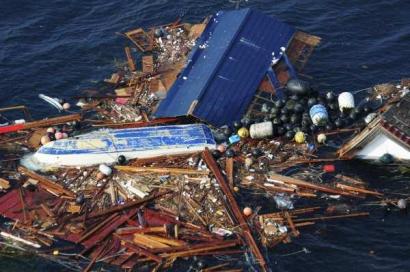
Residents of Vancouver Island, Alaska and the U.S. Pacific coast have said they’ve found large quantities of bottles, cans, lumber and floats.
バンクーバー島、アラスカ、アメリカ西海岸の住民は、大量のボトル、缶、木材や浮きを見つけた、と言っています。
The debris is part of 18 million tonnes of debris from Japan floating across the Pacific-taking up an area thought to be twice the size of Texas.
その瓦礫は、日本から流され、太平洋を漂流している1800万トンの瓦礫の一部で、その面積はテキサス州の2倍と考えられています。
The impact of the debris on the Pacific is unclear. Much of it is expected to eventually join an already massive patch of existing garbage floating in the Pacific gyre.
瓦礫が太平洋に与える影響は、明らかではありません。その多くが、最終的に、既にごみが浮いている北太平洋旋廻の「太平洋ゴミベルト」 に合流すると思われています。
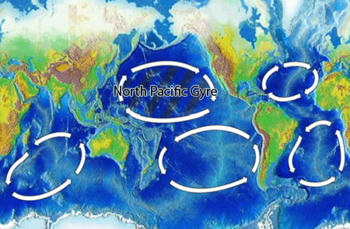
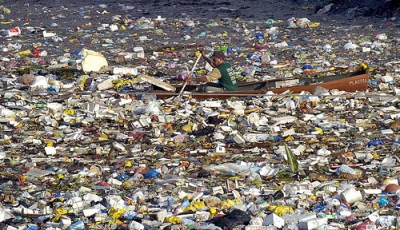
The arrival of the debris on the west coast also appears to have caught Canadian authorities off guard.
西海岸へ到着した瓦礫についても、カナダの政府筋は油断していたのが明らかになりました。
“What debris are you talking about?” Health Canada spokesman Gary Holub asked when contacted for a comment this week.
「なんの瓦礫のことを言っているのですか?」と、今週コメントを求めたところ、ヘルス・カナダのスポークスマン、Gary Holub氏はたずねました。
“Debris from Japan is not expected on the west coast of Canada for another year.”
「日本からの瓦礫は、あと一年はカナダの西海岸には到着することはないと推測されている。」
He asked a reporter to email him media stories about the debris. Later, Holub emailed a statement saying “there has been no official confirmation that the source of this debris is from the tsunami in Japan.”
彼はレポーターに、瓦礫についてのメディアの記事をEメールするように頼みました。後にHolub氏は、「この瓦礫が日本の津波によって流されたものだと正式に認められていない。」とEメールを送ってきました。
He said, “It is ‘highly unlikely’ the debris will be radioactive and that Health Canada will await scientific data before deciding whether to test any of it.”
「瓦礫が放射能を含んでいることは、”ほとんどありえない”ことで、ヘルス・カナダは、調査するか否かについて、科学的データを待つことになるだろう。」と書かれていました。
It’s also unclear how the debris will impact fish in the Pacific.
その瓦礫が、太平洋に生息する魚に、どのような影響を与えるのかも、明らかではないのです。
But there is a good chance Canadians have already eaten some of the types of fish most likely to be contaminated with cesium, based on the Japanese fisheries data.
ところが、日本の水産庁のデータを基にすると、カナダ人が既に、おそらくセシウムで汚染された魚をいくつか食べている可能性は大きいのです。
Japan exported $76 million of food products to Canada in 2010, including $13 million of fish and crustaceans. No figures were available for 2011.
日本の、2010年のカナダへの海産物の輸出高は7600万ドルです。1300万匹の魚、甲殻類が含まれます。2011年の数字はまだ出ていません。
The Gazette analyzed the Japanese fisheries data for 22 seafood species that Japan has exported to Canada in recent years.
Gazette紙は、ここ数年に日本がカナダに輸出していた海産物の22種の水産庁のデータを分析しました。
Some cesium was found in 16 of these 22 species in November, the last full month for which data was available.
1か月分全てのデータが出ている11月では、22種のうち16種からセシウムが見つかりました。
Cesium was especially prevalent in certain of the species:
セシウムは特定の種類から広く認められていました。
73 per cent of mackerel tested
調査されたさばの73%
91 per cent of the halibut
おひょうの91%
92 per cent of the sardines
いわしの92%
93 per cent of the tuna and eel
マグロとうなぎの93%
94 per cent of the cod and anchovies
タラとアンチョビの94%
100 per cent of the carp, seaweed, shark and monkfish
鯉、海藻、さめ、アンコウの100%
Some of the fish were caught in Japanese coastal waters. Other catches were made hundreds of kilometres away in the open ocean.
日本の海岸近くで取れるものも、何百キロも離れた沖で取れるものもあります。
There, the fish can also be caught by fishers from dozens of other nations that ply the waters of the Pacific.
そして、釣り上げられた魚は、太平洋を行き来する10数カ国のほかの国の漁師によるものでもあり得るのです。
Yet, Japan is the only country that appears to be systematically testing fish for radiation and publicly reporting the results.
しかし、日本は、組織的に魚の放射能を測り、公に結果を公表している唯一の国なのです。
CFIA is no longer doing any testing of its own. It did some radiation tests on food imports from areas of Japan around the stricken nuclear plant in the weeks after the Fukushima accident.
カナダ食品検査庁(CFIA)は、独自の調査をもう行っていません。福島事故の数週間後、原子力発電所付近の地域からの輸入食品の放射能検査をいくつかは行いました。
Only one of the 169 tested products showed any radiation. CFIA stopped doing the tests last June, saying they weren’t needed.
169食品のうち、1つだけ放射能を示していました。CFIAは去年の6月に、もう必要がないといい、検査を取り止めたのです。
“The quantities of radioactive material reaching Canada are very small and within normal ranges,” CFIA spokesperson Lisa Gauthier said in an emailed statement.
「カナダに到達した放射性物質の量はとても少なく、平常範囲なのです。」とCFIAのスポークスマン、Lisa GauthierさんはEメールで述べました。
“They do not pose any health risk to Canadians, the food we eat or the plants and animals in Canada.”
「カナダ人にとって危険を引き起こすことはありません。私たちが食べている食品、カナダ国内の植物と動物もです。」
In August, CFIA also tested a dozen samples of fish caught in B.C. coastal and inland waters. None of those tests found any radiation.
8月にCFIAはBC沿岸と内陸の海で捕れた魚を12匹検査しました。いずれも放射能は検出されませんでした。(参照:カナダ放射能汚染食品対策)
CFIA said it has no plans to do any other radiation tests on fish in the Pacific or imports from other nations that fish in the ocean, including Japan.
CFIAは、日本を含め、他国から輸出された太平洋の魚の放射能を調査する計画は全くない、と言いました。
CFIA now relies on Japanese authorities to screen Japanese food exported to Canada.
現在CFIAは、カナダに輸出する日本の食品のスクリーニングを、日本政府に依存しているのです。
But Japan’s monitoring of food has come under a storm of criticism from the Japanese public after food contaminated with radiation was sold to consumers.
しかし、日本の食品モニタリングについては、放射脳汚染食品が市場で販売されてから、日本人の批判の嵐を受けているのです。

Photo from NHK Special
A Canadian seafood industry official was surprised when told CFIA doesn’t plan any more tests of Pacific fish.
カナダの魚介類業界は、CFIAが太平洋の魚の調査をこれ以上計画していないと告げられた時、驚きました。
“It is certainly our expectation that the CFIA will test again this year,” said Christina Burridge, executive director of the B.C. Seafood Alliance.
「今年また、CFIAが調査するとばかり思っていました。」と、BC集漁業組合の代表、Christina Burridgeさんは言いました。
The alliance is an umbrella of Pacific seafood harvesting associations whose member firms generate about $700 million in yearly revenues.
その組合は、太平洋漁業協会の傘下にあり、メンバー企業は年間約7億ドルの収益を上げています。
Burridge said CFIA promised her group last spring it would test Pacific salmon and tuna returning to B.C. fishing grounds in 2012 and 2013 because of the possibility those fish could have migrated close to Japan.
Burridgeさんは、CFIAが去年の春、鮭やマグロが日本の近海まで移動する可能性があるので、2012/13年度に、BC州に戻ってきた太平洋の鮭とマグロを調査すると約束したのだ、と言います。
“We all agreed that if there was any risk of contamination, it would be in 2012 and 2013,” she said.
私たちは、もし、汚染の危険性があるとすれば、それは2012年と2013年になるだろうという見解で一致したのです。」
She wouldn’t comment on the Japanese fisheries data, which she hadn’t seen previously. But she said of the data: “It would reinforce our expectation that the CFIA would test this year.
彼女は、まだ見たことのない日本の水産庁のデータについてはコメントしませんでした。そのデータについては、「それは、CFIAに今年調査を行うだろうという期待を強めるものになるのでしょう。」と話しました。
“We want to be able to assure our customers that our expectation that there will be no increase in detectable levels (of radiation) is true,” she said.
「私たちは、放射能の検出値が増加することはないという予測が間違えではない、と言うことを、消費者に保証したいのです。」
She said she based this expectation on “a general belief that contamination will be limited to the coastal waters off Japan.”
それは、「一般的に汚染は日本の海岸の海水に限られていると思われている」という予測に基づいています。
But despite this belief and the importance of the Pacific fishery, few studies exist on how Fukushima affected marine life.
しかし、太平洋漁業のこの想いと重大性にもかかわらず、福島が海洋生物にどのように影響するかについての研究がほとんど行われていません。
One of those studies found that fish and crustaceans caught in the vicinity of Fukushima in late March had 10,000 times more than so-called safe levels of radiation. The study, published last May in the journal Environmental Science & Technology, also said macroalgae had 19,000 times the safe level.
ある研究では、3月末に福島近海で捕れた魚と甲殻類に、いわゆる安全な放射能レベルよりも1万倍高い値が見つけられました。5月末に「Environmental Science & Technology環境科学技術」という雑誌に発表されたその研究は、海藻に安全レベルの1万9千倍の汚染があった、と述べています。
Those levels were measured before the Japanese utility that runs the crippled nuclear plant dumped 11,000 tonnes of radioactive water into the Pacific in April and additional leaks that have released hundreds of tonnes more.
これらのレベルは、破壊された原子力発電所が4月に1万1000トンの放射能汚染水を太平洋に排出した前に測られたものです。そして更なる漏洩で、何百トンも放出されているのです。
But since that early study, little research has been published on the topic.
しかし、その早期の研究以来、この件について、ほとんどの調査が発表されていません。
“People want to know what’s happening with the cesium and how much is in the fish, but we don’t know. It’s frustrating,” said oceanographer Buesseler.
「みな、セシウムがどうなって、どれだけ魚を汚染しているのか知りたいのですが、分からないのです。やるせないです。」と海洋学者のBuesseler氏は話しました。
“It’s disconcerting how big of an event Fukushima was and how little data are out there. No one has taken responsibility for studying this in a single agency (in the U.S.), even though we also have reactors on the coast and other events could happen,” he said.
「福島の事故がどれだけ大きいものか、発表されているデータがどれだけ少ないかには、当惑させられます。(アメリカで)どの機関もこの研究に責任を持とうとしていないのです。海岸沿いに原子炉があり、同様の事故が起こりうるかも知れないというのに。」
SUNY’s Fisher agrees: “In the U.S., it’s very difficult to acquire funding to do that work. A lot of people are very frustrated. Funding agencies are already spread incredibly thin, and they were not prepared for this,” he said.
SUNYの Fishers氏も同意します。「アメリカでは、このような調査に基金を獲得するのがとても難しいのです。多くの人がとても失望しています。」基金提供機関は既に信じがたいほど割りあてが乏しく散りばめられ、この件については準備されていなかったのです。」

A radiation detector is used in Manhattan’s Sushi Yasuda restaurant in April. The restaurant has found no radiation contamination since it began using the detector as a precautionary measure in response to consumer concerns over possible contamination of seafood after the nuclear accident in Japan.
Photograph by: Mario Tama, Getty Images file photo
お客様の懸念を考え、4月に独自に検査するマンハッタンすしヤスダ。放射能は検出されませんでした。
After governments refused to provide funds, Buesseler, Fisher and other scientists secured funds from a private foundation for a research voyage in the Pacific to gather radiation data on fish, plankton and water.
政府が基金の提供を拒否した後、Buesseler氏とFisher氏、そして他の科学者たちは、魚、プランクトン、海水中の放射能データを収集するための太平洋調査の旅のため、民間の基金提供機関から、資金を調達しました。
Fisher can’t discuss his findings because they aren’t published yet. He expects to send them for publication in coming weeks.
Fisher氏は、まだ発表されていない結果については語れないと言います。数週間のうちに発表するつもりだと言うことです。
Buesseler has already reported some results from the 15-day cruise last May and June.
Buesseler氏は、5月と6月の15日間のクルーズでの結果をいくつか報告しています。
He co-authored the study in October that said cesium levels in the Pacific had gone up an astonishing 45 million times above pre-accident levels. The levels then declined rapidly for a while, but after that, they unexpectedly levelled off.
彼は10月に共同著作した研究で、太平洋のセシウムのレベルは事故前のレベルの4500万倍だと述べました。そのレベルはしばらくの間、急速に下がりました。しかしその後、予想に反して、横ばいなのです。
In July, cesium levels stopped declining and remained stuck at 10,000 times above pre-accident levels.
7月に、セシウムのレベルの降下は止まり、事故前の1万倍の値で止まったままです。
It meant the ocean wasn’t diluting the radiation as expected. If it had been, cesium levels would have kept falling. The finding suggested radiation was still being released into the ocean long after the accident in March, Buesseler said in an interview.
それは、海水が、期待していたほど放射能を薄めていない、と言うことを意味します。もし薄めているのであれば、セシウムのレベルは落ち続けるはずです。この結果は、3月後も長い間放射能がまだ海に放出されていることを示しているのだ、とBuesseler氏はインタビューで話しました。
“It implies the groundwater is contaminated or the facility is still leaking radiation.”
「それは地下水が汚染されているか、原発施設がまだ放射能を放出している、と言うことを暗示しているのです。」
The Japanese fisheries data seems to support this conclusion. Far from declining, contamination levels in some species were flat or even rose last fall, including species that Japan exports to Canada like skipjack tuna, cod, sole and eel.
日本水産庁のデータは、その結論を裏付けているようです。否定からはかけ離れています。数種の汚染レベルは横ばいか、むしろ去年の秋に上がっているものもありました。かつお、まぐろ、タラ、ひらめ、うなぎなど日本がカナダに輸出している種類を含めて、です。
In November, the average Japanese catch had 111 becquerels of cesium per kilogram – above the new radiation ceiling of 100 becquerels per kilo that Japan has announced it will implement for food this spring.
11月に、日本の漁獲物のセシウム平均は、1kgあたり111ベクレルでした。これは、日本がこの春から食品に対する制限値1kgあたり100ベクレルを施行すると発表した放射能限界値より高いものです。
The November level declined from a peak level of 373 becquerels per kilo last April. But it was an increase from the October average of 78 becquerels per kilo.
11月のレベルは去年4月ピークの1kgあたり373ベクレルからは下がっていますが、10月の1kb78ベクレルからは上がっているのです。
Such persistently elevated levels of radiation warrant more monitoring and research, Fisher said. “It’s not something we can easily dismiss.”
放射能のこのようにしつこく上がるレベルは、モニタリングや調査の必要性を物語っています。「このことは、簡単に退けられることではないのです。」とFisher氏は言いました。

Photo from NHK Special
Continuing radiation leaks from Fukushima could be to blame, he said. Another culprit, he said, may be a phenomenon called biomagnification – the tendency for radiation concentrations to increase in species that are farther up the food chain.
福島からの継続的な放射能漏洩は、責任を負うべきものだ、と彼は言います。もう1つの罪人は、拡大、と呼ばれる現象かもしれません。-放射能の濃縮が、種から種へ、はるか食物連鎖まで拡大するという傾向です。
About 2.7 per cent of the fish catches also exceeded Japan’s existing ceiling for food of 500 becquerels per kilo. That was also up from one per cent in October.
約2.7%の漁獲物が現在の日本の食品規定の1kgあたり500ベクレルを越しました。それは、10月の1%からも上がっています。
In November, 0.8 per cent of Japanese catches exceeded Canada’s ceiling of 1,000 becquerels per kilo, up from 0.2 per cent in October.
11月には、0.8%の日本の漁獲物がカナダの限界地1kgあたり1000ベクレルを超え、10月の0.2%から増えています。
But food with radiation below these limits can still pose health risks, Edwards believes. “There is no safe level of radiation. They should be making every effort to monitor food.”
しかし、これらの限界値より低い放射能を含む食品も、健康に危険をもたらすのだ、とEdwards氏は主張します。「放射能に安全レベルと言うのはありません。どんなことをしても食品のモニタリングをするべきなのです。」
© Copyright (c) The Montreal Gazette
ガイガーカウンターで食品をいくつか検査してみました。
I tried to measure some foods with my Geiger counter.
(YouTubeでこんな風に測っているのを見たのですが、でも、食品の中に含まれる汚染については、きっと測れてないのだと思いますが・・・)
(I saw someone measuring like this at YouTube, but I do not think this is the good way to measure food)
キッチンのカウンターで、
on my kitchen counter...

和歌山の梅干(バンクーバーで購入)
Pickled plum (bought at Japanese store in Vancouver)
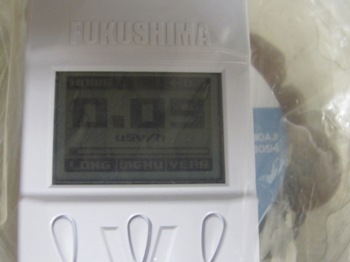
太平洋を遠く旅する、スモークSockeyeサーモン(紅鮭)、(バンクーバーで購入)
Migrating Sockeye Salmon (bought at Superstore)
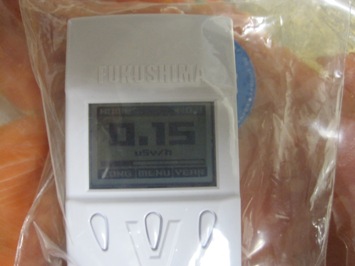
地元バーナビーのスーパーで焼いた食パン
Whole Wheat bread (baked at Burnaby Safeway bakery)
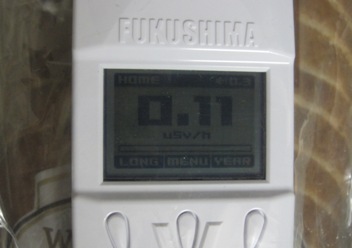
キッチンの空間線量は、大体0.08-0.11マイクロシーベルト
Background in the kitchen was 0.08-0.11 microSv/hour
なぜか外の雨どいの下は、0.05-0.08マイクロシーベルト
Right below the drainage outside was 0.05-0.08 microSv/hour
ちなみに、バーナビーの2010年の平均線量は、
Average background radiation in Burnaby in 2010 was
0.49マイクロシーベルト/DAY
0.49 microSv/day
つまり、毎時0.02マイクロシーベルト?!
Is it 0.02 microSv/hour?
No comments:
Post a Comment